新概念英语第一册语法总结(上)[八种时态]
- 格式:docx
- 大小:27.48 KB
- 文档页数:20
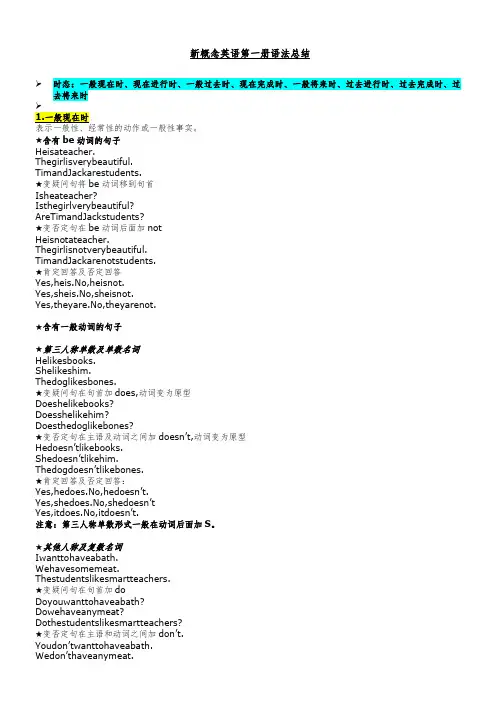
新概念英语第一册语法总结时态:一般现在时、现在进行时、一般过去时、现在完成时、一般将来时、过去进行时、过去完成时、过去将来时★含有be动词的句子Heisateacher.Thegirlisverybeautiful.TimandJackarestudents.★变疑问句将be动词移到句首★★★★★★★Yes,itdoes.No,itdoesn’t.注意:第三人称单数形式一般在动词后面加S。
★其他人称及复数名词Iwanttohaveabath.Wehavesomemeat.Thestudentslikesmartteachers.★变疑问句在句首加doDoyouwanttohaveabath?Dowehaveanymeat?Dothestudentslikesmartteachers?★变否定句在主语和动词之间加don’t.Youdon’twanttohaveabath.Wedon’thaveanymeat.Thestudentsdon’tlikesmartteachers.★肯定回答及否定回答Yes,Ido.No,Idon’t.Yes,wedo.No,wedon’tYes,theydo.No,theydon’t.构成:主语+be动词+动词的现在分词+其它成分Wearehavinglunch.Heisreadingabook.Thedogisrunningafteracat.Theboysareswimmingacrosstheriver.,如★变疑问句将be动词移动到句首Wereyouatthebutcher’s?Wereyouastudentayearago?Wastheteacherverybeautifultenyearsago?★变否定句在be动词后面加notIwasnotatthebutcher’s.Youwerenotastudentayearago.Theteacherwasnotverybeautifultenyearsago.★肯定回答否定回答Yes,Iwas.No,Iwasnot.Yes,youwere.No,youwerenot.Yes,he/shewas.No,he/shewasnot.★特殊疑问句:Whatdidyoudo?不含有be动词的句子,将动词变为过去式,动词过去式构成见附录Ifinishedmyhomeworkyesterday. Theboywenttoarestaurant. TheSawyerslivedatKingStreetayearago.KingStreetayearago.★变疑问句在句首加did,动词变为原型Didyoufinishyourhomeworkyesterday? Didtheboygotoarestaurant? DidtheSawyersliveatKingStreetayearago? KingStreetayearago?★变否定句在主语和动词之间加didnot,动词变为原型IhavebeentoLondon.(人已经回来) HehasgonetoLondon.(人还在那里)5)表示一种结果,一般不和时间副词联用Ihavelostmypen.Ihavehurtmyself.Hehasbecomeateacher.Shehasbrokenmyheart.句型变化:★变疑问句将助动词移到句首,变否定句在助动词后面加not. Haveyoulostyourpen?Ihavenotlostmypen.★肯定回答及否定回答Yes,Ihave.No,Ihavenot.★特殊疑问句:Whathaveyoudone?Whathashedone?一般过去时与现在完成时的区别:凡是有明确的表示过去的时间状语的句子为过去时注意:有些动词表示的动作有一个终点,不能再延续,因此不能和表示一段时间状语连用错:I’veleftBeijingfor3days.对:IleftBeijing3daysago.Ihavebeenawayfrombeingfor3days.将来将要发生的动作,经常和tomorrow,nextyear,thedayaftertomorrow,theyearafter thenext,infivehours’time,etc.表示将来的词★变否定句在助动词后面加notShehadn’tfinishedherhomework.★肯定回答及否定回答Yes,shehad.No,shehadn’t.★特殊疑问句:Whathadshedone?when,while,as引导的状语从句中。

新概念第一册八大时态总结一.一般现在时1.结构基本结构否定句一般疑问句be动词am/is/are+not be提前,放于句首实义动词don’t/doesn’t+do(动词原形)Do/Does+主语+do(动词原形)…?2.用法1)表示经常的、习惯性的动作或存在的状态,常与表示频度的副词连用。
常用的频度副词有:always、often、usually、seldom、never、sometimes, every week (day, year, month…), once a week, on Sundays.频度副词在句中通常放在行为动词之前,系动词、助动词之后。
2)表示主语具备的性格、特征和能力等。
All my friends love football .3)表示客观真理、客观存在、自然现象。
The earth moves around the sun.4)if 引导的条件状语从句主将从现I'll tell him the news if he comes back.二.一般过去时态1.结构基本结构否定句一般疑问句be动词was/were+not was/were提前,放于句首实义动词didn’t+do(动词原形)Did+主语+do(动词原形)…?2.用法表示过去某一时刻或某一段时间里所发生的动作或情况。
常和表示过去的时间状语yesterday, just now, the other day(几天前), in 1982, ago, an hour ago, long long ago, the day before yesterday, last week(year, night, month…), at the age of 5, one day, once upon a time等连用三.一般将来时1.结构一、句型结构:1.be going to 主语+(am/is/are)going to +动词原形2.will :主语+will+动词原形(will为助动词,与情态动词用法相同,与动词原形构成谓语,不需要根据人称进行变化。
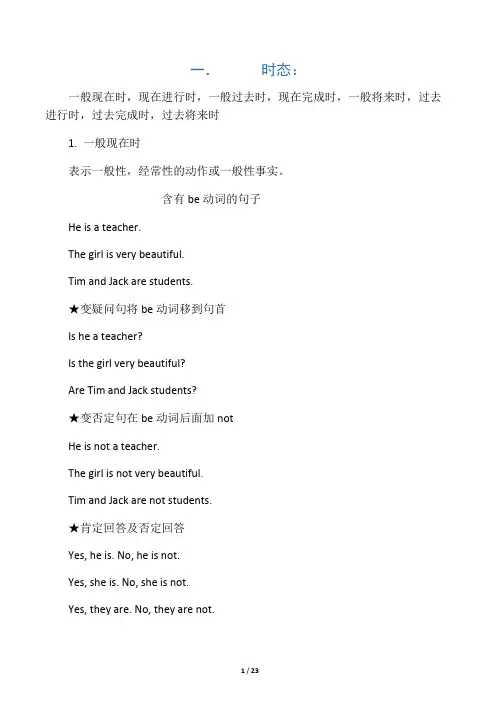
一.时态:一般现在时,现在进行时,一般过去时,现在完成时,一般将来时,过去进行时,过去完成时,过去将来时1. 一般现在时表示一般性,经常性的动作或一般性事实。
含有be动词的句子He is a teacher.The girl is very beautiful.Tim and Jack are students.★变疑问句将be动词移到句首Is he a teacher?Is the girl very beautiful?Are Tim and Jack students?★变否定句在be动词后面加notHe is not a teacher.The girl is not very beautiful.Tim and Jack are not students.★肯定回答及否定回答Yes, he is. No, he is not.Yes, she is. No, she is not.Yes, they are. No, they are not.不含有动词的句子,即含有一般动词的句子第三人称单数及单数名词He likes books.She likes him.The dog likes bones.★变疑问句在句首加does, 动词变为原型Does he like books?Does she like him?Does the dog like bones?★变否定句在主语及动词之间加doesn’t, 动词变为原型He doesn’t like books.She doesn’t like him.The dog doesn’t like bones.★肯定回答及否定回答:Yes, he does. No, he doesn’t.Yes, she does. No, she doesn’tYes, it does. No, it doesn’t.注意:第三人称单数形式一般在动词后面加S,不要和名词复数混淆,变否定句或疑问句时名词复数没有任何变化。
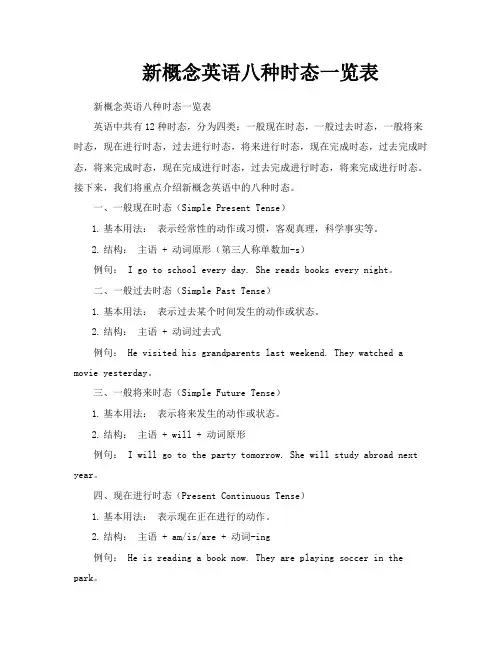
新概念英语八种时态一览表新概念英语八种时态一览表英语中共有12种时态,分为四类:一般现在时态,一般过去时态,一般将来时态,现在进行时态,过去进行时态,将来进行时态,现在完成时态,过去完成时态,将来完成时态,现在完成进行时态,过去完成进行时态,将来完成进行时态。
接下来,我们将重点介绍新概念英语中的八种时态。
一、一般现在时态(Simple Present Tense)1.基本用法:表示经常性的动作或习惯,客观真理,科学事实等。
2.结构:主语 + 动词原形(第三人称单数加-s)例句: I go to school every day. She reads books every night。
二、一般过去时态(Simple Past Tense)1.基本用法:表示过去某个时间发生的动作或状态。
2.结构:主语 + 动词过去式例句: He visited his grandparents last weekend. They watched a movie yesterday。
三、一般将来时态(Simple Future Tense)1.基本用法:表示将来发生的动作或状态。
2.结构:主语 + will + 动词原形例句: I will go to the party tomorrow. She will study abroad next year。
四、现在进行时态(Present Continuous Tense)1.基本用法:表示现在正在进行的动作。
2.结构:主语 + am/is/are + 动词-ing例句: He is reading a book now. They are playing soccer in the park。
五、过去进行时态(Past Continuous Tense)1.基本用法:表示过去某个时间正在进行的动作。
2.结构:主语 + was/were + 动词-ing例句: She was studying when I called her. They were watching TV at that time。
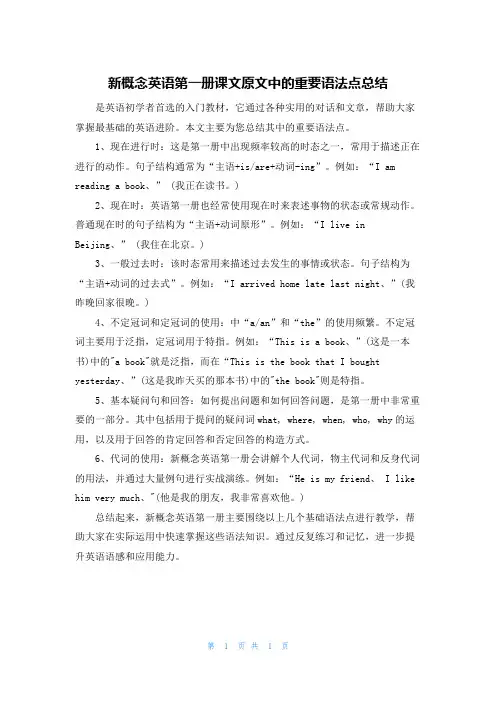
新概念英语第一册课文原文中的重要语法点总结是英语初学者首选的入门教材,它通过各种实用的对话和文章,帮助大家掌握最基础的英语进阶。
本文主要为您总结其中的重要语法点。
1、现在进行时:这是第一册中出现频率较高的时态之一,常用于描述正在进行的动作。
句子结构通常为“主语+is/are+动词-ing”。
例如:“I am reading a book、” (我正在读书。
)2、现在时:英语第一册也经常使用现在时来表述事物的状态或常规动作。
普通现在时的句子结构为“主语+动词原形”。
例如:“I live in Beijing、” (我住在北京。
)3、一般过去时:该时态常用来描述过去发生的事情或状态。
句子结构为“主语+动词的过去式”。
例如:“I arriv ed home late last night、”(我昨晚回家很晚。
)4、不定冠词和定冠词的使用:中“a/an”和“the”的使用频繁。
不定冠词主要用于泛指,定冠词用于特指。
例如:“This is a book、”(这是一本书)中的"a book"就是泛指,而在“This is the book that I bought yesterday、”(这是我昨天买的那本书)中的"the book"则是特指。
5、基本疑问句和回答:如何提出问题和如何回答问题,是第一册中非常重要的一部分。
其中包括用于提问的疑问词what, where, when, who, why的运用,以及用于回答的肯定回答和否定回答的构造方式。
6、代词的使用:新概念英语第一册会讲解个人代词,物主代词和反身代词的用法,并通过大量例句进行实战演练。
例如:“He is my friend、 I like him very much、"(他是我的朋友,我非常喜欢他。
)总结起来,新概念英语第一册主要围绕以上几个基础语法点进行教学,帮助大家在实际运用中快速掌握这些语法知识。
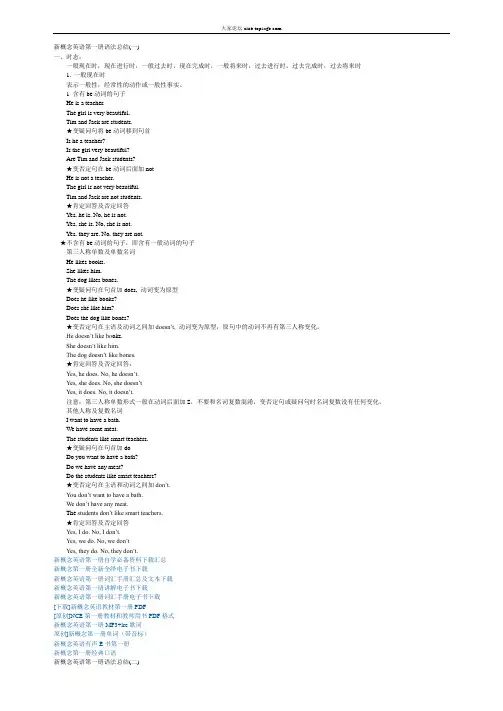
新概念英语第一册语法总结(一)一、时态:一般现在时,现在进行时,一般过去时,现在完成时,一般将来时,过去进行时,过去完成时,过去将来时1. 一般现在时表示一般性,经常性的动作或一般性事实。
1 含有be动词的句子He is a teacher.The girl is very beautiful.Tim and Jack are students.★变疑问句将be动词移到句首Is he a teacher?Is the girl very beautiful?Are Tim and Jack students?★变否定句在be动词后面加notHe is not a teacher.The girl is not very beautiful.Tim and Jack are not students.★肯定回答及否定回答Y es, he is. No, he is not.Y es, she is. No, she is not.Y es, they are. No, they are not.★不含有be动词的句子,即含有一般动词的句子第三人称单数及单数名词He likes books.She likes him.The dog likes bones.★变疑问句在句首加does, 动词变为原型Does he like books?Does she like him?Does the dog like bones?★变否定句在主语及动词之间加doesn’t, 动词变为原型,原句中的动词不再有第三人称变化。
He doesn’t like bo oks.She doesn’t like him.The dog doesn’t like bones.★肯定回答及否定回答:Y es, he does. No, he doesn’t.Y es, she does. No, she doesn’tY es, it does. No, it doesn’t.注意:第三人称单数形式一般在动词后面加S,不要和名词复数混淆,变否定句或疑问句时名词复数没有任何变化。
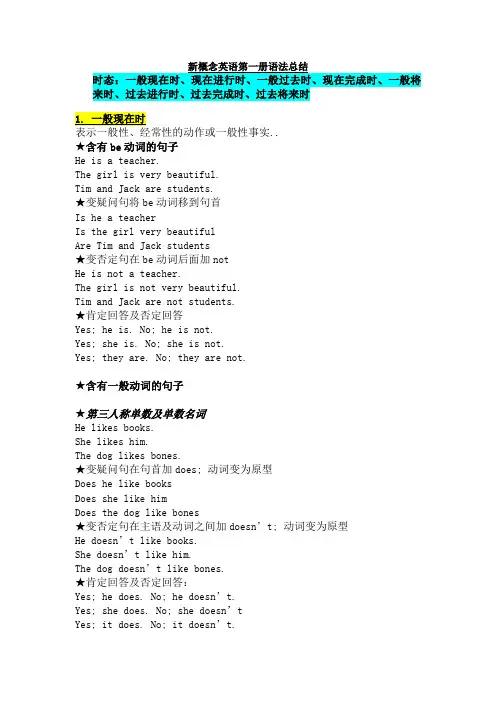
新概念英语第一册语法总结时态:一般现在时、现在进行时、一般过去时、现在完成时、一般将来时、过去进行时、过去完成时、过去将来时1. 一般现在时..★含有be动词的句子He is a teacher.The girl is very beautiful.Tim and Jack are students.★变疑问句将be动词移到句首Is he a teacherIs the girl very beautifulAre Tim and Jack students★变否定句在be动词后面加notHe is not a teacher.The girl is not very beautiful.Tim and Jack are not students.★肯定回答及否定回答Yes; he is. No; he is not.Yes; she is. No; she is not.Yes; they are. No; they are not.★含有一般动词的句子★第三人称单数及单数名词He likes books.She likes him.The dog likes bones.★变疑问句在句首加does; 动词变为原型Does he like booksDoes she like himDoes the dog like bones★变否定句在主语及动词之间加doesn’t; 动词变为原型He doesn’t like books.She doesn’t like him.The dog doesn’t like bones.★肯定回答及否定回答:Yes; he does. No; he doesn’t.Yes; she does. No; she doesn’tYes; it does. No; it doesn’t.注意:第三人称单数形式一般在动词后面加S..★其他人称及复数名词I want to have a bath.We have some meat.The students like smart teachers.★变疑问句在句首加doDo you want to have a bathDo we have any meatDo the students like smart teachers★变否定句在主语和动词之间加don’t.You don’t want to have a bath.We don’t have any meat.The students don’t like smart teachers.★肯定回答及否定回答Yes; I do. No; I don’t.Yes; we do. No; we don’tYes; they do. No; they don’t...构成:主语+be动词+动词的现在分词+其它成分We are having lunch.He is reading a book.The dog is running after a cat.The boys are swimming across the river.★变疑问句将be动词移到句首Are we having lunchIs he reading a bookIs the dog running after a catAre the boys swimming across the river★变否定句在be动词后面加notWe are not having lunch.He is not reading a book.The dog is not running after a cat.The boys are swimming across the river.★特殊疑问句:what; which; how; where; who; etc. 疑问词+be动词+主语+现在分词What are you doingWhat is she doingWhat is the dog doing没有进行时的动词必背表示状态、思想、感情、感觉的动词不能表示正在进行的动作1. 表示感觉、感官的词see; hear; like; love; want2. have; has作为动词”拥有”的含义时;没有进行时;常和表示过去的时间状语连用;如yesterday; last night; the day before yesterday; three days ago.含有be动词的句子;将动词变为过去式;am / is的变为was;are的变为wereI was at the butcher’s.You were a student a year ago.The teacher was very beautiful ten years ago.★变疑问句将be动词移动到句首Were you at the butcher’sWere you a student a year agoWas the teacher very beautiful ten years ago★变否定句在be动词后面加notI was not at the butcher’s.You were not a student a year ago.The teacher was not very beautiful ten years ago.★肯定回答否定回答Yes; I was. No; I was not.Yes; you were. No; you were not.Yes; he/she was. No; he/she was not.★特殊疑问句:What did you do不含有be动词的句子;将动词变为过去式;动词过去式构成见附录I finished my homework yesterday.The boy went to a restaurant.The Sawyers lived at King Streeta year ago.King Streeta year ago.★变疑问句在句首加did;动词变为原型Did you finish your homework yesterdayDid the boy go to a restaurantDid the Sawyers live at King Streeta year agoKing Streeta year ago★变否定句在主语和动词之间加did not;动词变为原型I did not finish my homework yesterday.The boy did not go to a restaurant.The Sawyers did not live at King Streeta year ago.King Streeta year ago.★肯定回答及否定回答Yes; I did. No; I didn’t.Yes; he did. No; he didn’t.Yes; they did. No; they did not.have/has+过去分词用法:1表示过去发生且和现在有某种联系的动作;常和just; usually; already; since等时间副词连用I have just had lunch. 饱了;不用再吃了He has had a cup of tea.不渴了;不用再喝They have already had their holiday. 不能再度假了The boy has already read the book. 已经知道书的内容了;不用再看了2询问别人是否做过某事一般用现在完成时Have you finished your homeworkHave you been to BeijingHave he seen the film3表示开始于过去并持续到现在的动作I have lived in Beijing for twenty years.I have worked for this school for 1 year.4表示一种经历、经验:去过…地方;做过…事情;经历过…事情I have never had a bath.I have never seen a film.I have never been to cinema.I have ever been to Paris.Have been to表示去过;have gone to 表示去了I have been to London.人已经回来He has gone to London.人还在那里5表示一种结果;一般不和时间副词联用I have lost my pen.I have hurt myself.He has become a teacher.She has broken my heart.句型变化:★变疑问句将助动词移到句首;变否定句在助动词后面加not.Have you lost your pen I have not lost my pen.★肯定回答及否定回答Yes; I have. No; I have not.★特殊疑问句:What have you doneWhat has he done一般过去时与现在完成时的区别:凡是有明确的表示过去的时间状语的句子为过去时注意:有些动词表示的动作有一个终点;不能再延续;因此不能和表示一段时间状语连用错:I’ve left Beijing for 3 days.对:I left Beijing 3 days ago. I have been away from being for 3 days.; 经常和tomorrow; next year; the day after tomorrow; the year after the next; in five hours’ time; etc. 表示将来的词联用结构:主语+助动词will+动词原形I will go to America tomorrow.The pilot will fly to Japan the month after the next.Jack will move into his new house tomorrow morning.★变疑问句将助动词移到句首Will you go to America tomorrowWill the pilot fly to Japan the month after the nextWill Jack move into his new house tomorrow morning★变否定句在助动词后面加notI will not go to America tomorrow.The pilot will not fly to Japan the month after the next.Jack will not move into his new house tomorrow morning★肯定回答及否定回答Yes; I will. No; I will not.Yes; he/she will. No; he/she will not.Yes; he will. No; he will not.★特殊疑问句:What will you do;两个动作中;发生在前的哪个动作要用过去完成时..结构:had+过去分词After she had finished her homework; she went shopping.They had sold the car before I asked the price.The train had left before I arrived at the station.After/before引导的时间状语从句放在句首要在句子后面加逗号;如果放在主句后则不用..★变疑问句将助动词移到句首Had she finished her homework★变否定句在助动词后面加notShe hadn’t finished her homework.★肯定回答及否定回答Yes; she had. No; she hadn’t.★特殊疑问句:What had she done7. 过去进行时表示过去正在进行的动作;经常用在when; while; as引导的状语从句中.. 结构:was/were+doingWhen my husband was going into the dining room this morning; he dropped some coins on the floor.While we were having dinner; my father was watching TV.8.过去将来时结构:would do动词原型She said she would go here the next morning.一般现在时:do; does/am; is; are现在进行时:am; is; are一般过去时:did现在完成时:have; has一般将来时:will; shall过去进行时:was; were过去完成时:had过去将来时:would特殊句型:there be句型;be going to结构1. be going to 结构表示打算、准备、计划做某事★结构:主语+be动词+going to +动词原型I am going to make a bookcase.They are going to paint it.The father is going to give the bookcase to his daughter.★变疑问句将be动词移到句首Are you going to make a bookcaseAre they going to paint itIs the father going to give the bookcase to his daughter★变否定句在be动词后面加notI am not going to make a bookcase.They are going to paint it.The father is not going to give the bookcase to his daughter. ★肯定回答及否定回答Yes; I am. No; I am not.Yes; they are. No; they are not.Yes; he is. No; he is not.★特殊疑问句What are you going to doWhat are they going to doWhat is the father going to do2. There be 句型表示哪里有什么东西某处有某物There is+单数名词+表示场所的词一般为介词词组There is a book in this room.There is a pen on the tableThere are+复数名词+表示场所的词一般为介词词组There are two pens on the table.There are three schools there.★变疑问句将be动词移到句首Is there a book in this roomAre there two pens on the table★变否定句在动词后面加notThere is not a book in this room.There are not two pens on the table.★肯定回答及否定回答Yes; there is. No; there is not.Yes; there are. No; there are not.一般疑问句、特殊疑问句、选择疑问句、反意疑问句、选择疑问句、否定疑问句一般疑问句: 助动词/be动词+主语Are you a teacher Do you want to have a cup of tea特殊疑问句: 特殊疑问词+一般疑问句What is your name选择疑问句: orDo you want beef or lamb反意疑问句: 肯定陈述句+否定疑问部分;否定陈述部分+肯定疑问部分You don’t need that pen; do youYou need that pen; don’t you否定疑问句: 一般疑问句+否定词表达肯定的意思Aren’t you lucky Don’t you want have a rest限定词:some; any; many; muchsome; any 修饰可数名词或不可数名词;some用于肯定句;any用于否定句和疑问句;注意;当期待对方的答案为肯定回答时用some.many修饰可数名词;much修饰不可数名词;在口语中表示很多一般不用many; much; 而用a lot of/lots of; 在否定句中表示很多用many; much.I have a lot of money. I don’t have much money.名词:分类、复数形式、名词所有格名词分为可数名词和不可数名词不可数名词无法分开的东西:water; tea; bread; milk; rice米抽象的东西:love; beauty; coldness寒冷不可数名词有以下特点:不能用a; an修饰不能加s和单数be动词或动词搭配可数名词:单数可数名词要用冠词修饰;复数可数名词要在名词后面加s;名词复数共规则变化的名词复数形式规则1一般情况+se.g. shell→shells book→books规则2以s; x; ch; sh结尾+es e.g. fox→foxeschurch →churches; bus→buses; watch→watches规则3以o结尾+s或+ese.g. potato→potatoes; Negro→Negroes; hero→heroes; tomato→tomatoes;口诀:黑人英雄爱吃土豆和西红柿;剩下一般加s; radio→radios规则4以f; fe结尾的;变f; fe为vese.g. life→liveshalf→halves; shelf→shelves; city→cities; wife→wives规则5以辅音字母+y结尾; 变y为i+ese.g. sky→skiesfly→flies不规则变化的名词复数形式单数man woman foot goose tooth 复数men women feet geese teeth 单数child sheep deer mouse fish 复数children sheep deer mice fish 副词:用法、形容词变副词的变化副词可以修饰形容词、动词、副词或整个句子..如:The book is very good.He runs fast.She came here quite early.Certainly I will go with you.形容词变副词的变化:1.直接在形容词后加-ly;careful-carefully; slow-slowly;2.以辅音字母加y结尾的形容词;把y变i; 加-ly;happy-happily; lucky-luckily3.有些词形容词和副词的形式相同;不需要做任何变化fast; hard; late4.有些词加上-ly后意思与原词相差很远:near-nearly; high-highly; late-lately;情态动词:can; must; may; might; need1.情态动词can能够; must必须; may可以结构:主语+can/must/may+动词原型He can make the tea.Sally can air the room.We can speak English.★变疑问句将情态动词移到句首Can he make the teaCan Sally air the roomCan we speak English★变否定句在情态动词后面加notHe cannot make the tea.Sally cannot air the room.We cannot speak English.★肯定回答及否定回答Yes; he can. No; he cannot.Yes; she can. No; she cannot.Yes; we can. No; we cannot.★特殊疑问句:What can you do注意:情态动词的句子没有第三人称单数的变化;不要在情态动词或动词后面加S..2.Must/have to的区别must 表示必须;是主观上觉得应该做;must 只能用在表示现在和将来的句子里;have to是不得不;是由于客观条件逼迫的必要要做;have to do可以用在任何时态3.must; may; might表示猜测must do 表示对现在事实的猜测must have done表示对过去事实的猜测must have been doing 表示对过去正在进行的事实的猜测may/might do; may/might have done表示没有任何事实依据的猜测;might的可能性更小..can’t/couldn’t 表示不可能4.need 用法表示“需要”时为实意动词;后面可以加名词;也可以加不定式:I need a pen. Do you need any beer No; I don’t.I need to have a rest.Need doing=need to be done;表示被动The flowers need watering.Need在否定时做情态动词使用You needn’t go so early. =You don’t need to go so early.Must I clean the desk right now No; you needn’t.不定代词及不定副词:Some any no everything something anything nothing everything one someone anyone anything everyone where somewhere anywhere anywhere everywhere body somebody anybody nobody everybodyI looked for my book everywhere; but I can’t find it anywhere. If you want go somewhere; if you want to be someone; you must wake up.Help Somebody AnybodyYou are really something.Since everybody is here; let’s begin our class.Where did you go I went nowhere.Nobody is at home.I have nothing left.感叹句What +名词+主语+谓语What a beautiful girl she isHow + 形容词+主语+谓语How beautiful the girl is祈使句第二人称祈使句的否定;加don’tlet+其他人称代词反意疑问祈使句第二人称祈使句表示请求;命令;建议;邀请等;谓语动词一律用原型;句子中通常不用主语;句末用惊叹好或者句号;用降调..★肯定句:动词原型Come here; please.Go downstairs; please.Stand up. Sit down.Be quiet. Be careful.祈使句中如果有唤语;一定要用逗号隔开;放在句首或者句尾Come in; Amy.Sit down here; Tom.Mary; give me a book please.★否定:Don't+动词原型Don't come here.Don’t sit down.Don’t stand up.Don’t give me it.★let sb. doLet me pass.Let us have a rest.Let’s have a rest.★反意疑问Let’s have a walk along the river; shall weLet us go out for a drink; will you倒装句:so/neither的倒装He can swim. So can I.I didn’t go to class. Neither did I.结构:so/neither+be+ 主语so/neither+助动词+ 主语so/neither+情态动词+ 主语直接引语/间接引语如果引语的主句所用动词为过去时;那么间接引语要做相应变化:时态、人称、时间地点及指示词★时态变化:一般现在时——一般过去时现在进行时——过去进行时一般过去时——过去完成时现在完成时——过去完成时一般将来时——过去将来时be going to——was/were going to/wouldcan——couldmay——might★时间地点及指示词的变化:here—there; tomorrow—the next day; the following day; this—that…★人称变化:根据句意改变人称..直接宾语/间接宾语主语+及物动词+间接宾语+直接宾语直接宾语是及物动词的直接对象;间接宾语是及物动词的动作所涉及的人或事务;也可以说间接宾语表示动作是对谁做的;或者是为谁做的..所以间接宾语要用名词或者宾格代词来担当..He gives me a book.me间接宾语; a book直接宾语直接宾语和间接宾语的位置调换时要加一个介词to或for主语+及物动词+直接宾语+介词+间接宾语Give me a book.Give the book to me.Send his a letter.Send a letter to him.Show him the new dress.Show the new dress to him从句:宾语从句、定语从句限定性、表语从句、状语从句if宾语从句:如果宾语从句的主句中的动词为过去时;那么宾语从句中的时态要和主句统一;如果宾语从句为疑问词引导;那么语序要用陈述语序;即主语在前;动词在后..定语从句:表语从句:状语从句if引导的真实条件句:主句用一般将来时;从句用一般现在时What will you do if you win a lot of moneyIf it rains tomorrow; I will stay at home.动词不定式做宾语及宾语补语的用法结构: to do用法:可以做除谓语以外的所有成分;语法上称之为非谓语动词..做宾语:在一些动词后常用不定式做宾语;例如:want; like; ask ;try…做宾补:want sb. to do; ask sb. to do; like sb. to do…附录:代词及be动词名词复数动词的第三人称单数形式动词现在分词动词过去式过去式的读音形容词的比较级代词及be动词代词及be动词第一人称第二人称第三人称单数复数单数复数单数复数I am=I’mare=’reis not=isn’t/ iznt/ are not=aren’t /a:nt/ do not=don’tdoes not=doesn’twas=’sdid not=didn’tcan not=can’thave=’vehas=’shave not=haven’thas not=hasn’twill=’ll。
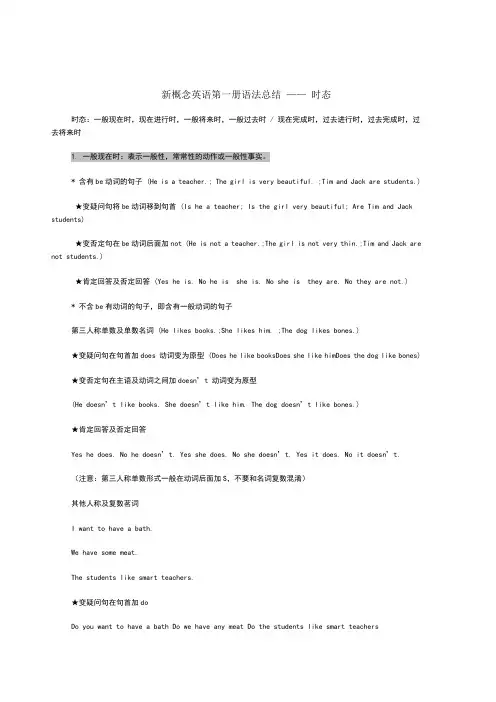
新概念英语第一册语法总结——时态时态:一般现在时,现在进行时,一般将来时,一般过去时 / 现在完成时,过去进行时,过去完成时,过去将来时1. 一般现在时:表示一般性,常常性的动作或一般性事实。
* 含有be动词的句子 (He is a teacher.; The girl is very beautiful. ;Tim and Jack are students.)★变疑问句将be动词移到句首 (Is he a teacher; Is the girl very beautiful; Are Tim and Jack students)★变否定句在be动词后面加not (He is not a teacher.;The girl is not very thin.;Tim and Jack are not students.)★肯定回答及否定回答 (Yes he is. No he is she is. No she is they are. No they are not.)* 不含be有动词的句子,即含有一般动词的句子第三人称单数及单数名词 (He likes books.;She likes him. ;The dog likes bones.)★变疑问句在句首加does 动词变为原型 (Does he like booksDoes she like himDoes the dog like bones)★变否定句在主语及动词之间加doesn’t 动词变为原型(He doesn’t like books. She doesn’t like him. The dog doesn’t like bones.)★肯定回答及否定回答Yes he do es. No he doesn’t. Yes she does. No she doesn’t. Yes it does. No it doesn’t.(注意:第三人称单数形式一般在动词后面加S,不要和名词复数混淆)其他人称及复数茗词I want to have a bath.We have some meat.The students like smart teachers.★变疑问句在句首加doDo you want to have a bath Do we have any meat Do the students like smart teachers★变否定句在主语和动词之间加don’t.You don’t want to have a bath. We don’t have any meat. The students don’t like smart teachers.★肯定回答及否定回答Yes I do. No I don’t. Yes we do. No we don’t. Yes they do. No they don’t.2. 现在进行时,表示现在正在进行的动作。
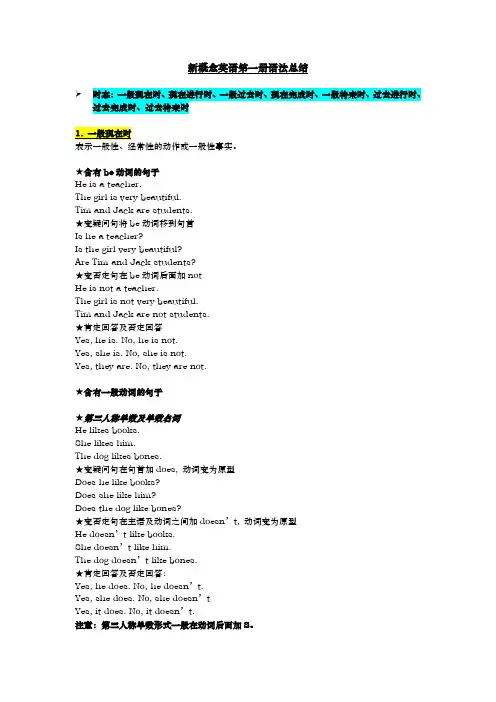
新概念英语第一册语法总结➢时态:一般现在时、现在进行时、一般过去时、现在完成时、一般将来时、过去进行时、过去完成时、过去将来时★含有be动词的句子He is a teacher.The girl is very beautiful.Tim and Jack are students.★变疑问句将be动词移到句首Is he a teacher?Is the girl very beautiful?Are Tim and Jack students?★变否定句在be动词后面加notHe is not a teacher.The girl is not very beautiful.Tim and Jack are not students.★肯定回答及否定回答Yes, he is. No, he is not.Yes, she is. No, she is not.Yes, they are. No, they are not.★含有一般动词的句子★第三人称单数及单数名词He likes books.She likes him.The dog likes bones.★变疑问句在句首加does, 动词变为原型Does he like books?Does she like him?Does the dog like bones?★变否定句在主语及动词之间加doesn’t, 动词变为原型He doesn’t like books.She doesn’t like him.The dog doesn’t like bones.★肯定回答及否定回答:Yes, he does. No, he doesn’t.Yes, she does. No, she doesn’tYes, it does. No, it doesn’t.注意:第三人称单数形式一般在动词后面加S。
★其他人称及复数名词I want to have a bath.We have some meat.The students like smart teachers.★变疑问句在句首加doDo you want to have a bath?Do we have any meat?Do the students like smart teachers?★变否定句在主语和动词之间加don’t.You don’t want to have a bath.We don’t have any meat.The students don’t like smart teachers.★肯定回答及否定回答Yes, I do. No, I don’t.Yes, we do. No, we don’tYes, they do. No, they don’t.构成:主语+be动词+动词的现在分词+其它成分We are having lunch.He is reading a book.The dog is running after a cat.The boys are swimming across the river.★变疑问句将be动词移到句首Are we having lunch?Is he reading a book?Is the dog running after a cat?Are the boys swimming across the river?★变否定句在be动词后面加notWe are not having lunch.He is not reading a book.The dog is not running after a cat.The boys are swimming across the river.★特殊疑问句:what, which, how, where, who, etc.疑问词+be动词+主语+现在分词What are you doing?What is she doing?What is the dog doing?没有进行时的动词(必背)表示状态、思想、感情、感觉的动词不能表示正在进行的动作1. 表示感觉、感官的词see, hear, like, love, want2. have, has作为动词”拥有”的含义时,没有进行时常和表示过去的时间状语连用,如yesterday, last night, the day before yesterday, three days ago.含有be动词的句子,将动词变为过去式,am / is的变为was,are的变为wereI was at the butcher’s.You were a student a year ago.The teacher was very beautiful ten years ago.★变疑问句将be动词移动到句首Were you at the butcher’s?Were you a student a year ago?Was the teacher very beautiful ten years ago?★变否定句在be动词后面加notI was not at the butcher’s.You were not a student a year ago.The teacher was not very beautiful ten years ago.★肯定回答否定回答Yes, I was. No, I was not.Yes, you were. No, you were not.Yes, he/she was. No, he/she was not.★特殊疑问句:What did you do?不含有be动词的句子,将动词变为过去式,动词过去式构成见附录I finished my homework yesterday.The boy went to a restaurant.The Sawyers lived at King Streeta year ago.King Streeta year ago.★变疑问句在句首加did,动词变为原型Did you finish your homework yesterday?Did the boy go to a restaurant?Did the Sawyers live at King Streeta year ago?King Streeta year ago?★变否定句在主语和动词之间加did not,动词变为原型I did not finish my homework yesterday.The boy did not go to a restaurant.The Sawyers did not live at King Streeta year ago.King Streeta year ago.★肯定回答及否定回答Yes, I did. No, I didn’t.Yes, he did. No, he didn’t.Yes, they did. No, they did not.have/has+过去分词用法:1)表示过去发生且和现在有某种联系的动作,常和just, usually, already, since等时间副词连用I have just had lunch. (饱了,不用再吃了)He has had a cup of tea.(不渴了,不用再喝)They have already had their holiday. (不能再度假了)The boy has already read the book. (已经知道书的内容了,不用再看了)2)询问别人是否做过某事一般用现在完成时Have you finished your homework?Have you been to Beijing?Have he seen the film?3)表示开始于过去并持续到现在的动作I have lived in Beijing for twenty years.I have worked for this school for 1 year.4)表示一种经历、经验:去过…地方,做过…事情,经历过…事情I have never had a bath.I have never seen a film.I have never been to cinema.I have ever been to Paris.Have been to表示去过,have gone to 表示去了I have been to London.(人已经回来)He has gone to London.(人还在那里)5)表示一种结果,一般不和时间副词联用I have lost my pen.I have hurt myself.He has become a teacher.She has broken my heart.句型变化:★变疑问句将助动词移到句首,变否定句在助动词后面加not.Have you lost your pen? I have not lost my pen.★肯定回答及否定回答Yes, I have. No, I have not.★特殊疑问句:What have you done?What has he done?一般过去时与现在完成时的区别:凡是有明确的表示过去的时间状语的句子为过去时注意:有些动词表示的动作有一个终点,不能再延续,因此不能和表示一段时间状语连用错:I’ve left Beijing for 3 days.对:I left Beijing 3 days ago. I have been away from being for 3 days.经常和tomorrow, next year, the day after tomorrow, the year after the next, in five hours’ time, etc. 表示将来的词联用结构:主语+助动词will+动词原形I will go to America tomorrow.The pilot will fly to Japan the month after the next.Jack will move into his new house tomorrow morning.★变疑问句将助动词移到句首Will you go to America tomorrow?Will the pilot fly to Japan the month after the next?Will Jack move into his new house tomorrow morning?★变否定句在助动词后面加notI will not go to America tomorrow.The pilot will not fly to Japan the month after the next.Jack will not move into his new house tomorrow morning★肯定回答及否定回答Yes, I will. No, I will not.Yes, he/she will. No, he/she will not.Yes, he will. No, he will not.★特殊疑问句:What will you do?结构:had+过去分词After she had finished her homework, she went shopping.They had sold the car before I asked the price.The train had left before I arrived at the station.After/before引导的时间状语从句放在句首要在句子后面加逗号,如果放在主句后则不用。
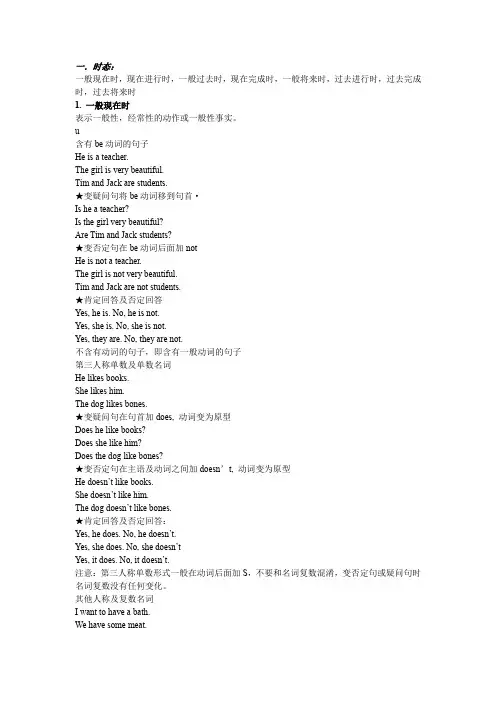
一.时态:一般现在时,现在进行时,一般过去时,现在完成时,一般将来时,过去进行时,过去完成时,过去将来时1. 一般现在时表示一般性,经常性的动作或一般性事实。
u含有be动词的句子He is a teacher.The girl is very beautiful.Tim and Jack are students.★变疑问句将be动词移到句首·Is he a teacher?Is the girl very beautiful?Are Tim and Jack students?★变否定句在be动词后面加notHe is not a teacher.The girl is not very beautiful.Tim and Jack are not students.★肯定回答及否定回答Yes, he is. No, he is not.Yes, she is. No, she is not.Yes, they are. No, they are not.不含有动词的句子,即含有一般动词的句子第三人称单数及单数名词He likes books.She likes him.The dog likes bones.★变疑问句在句首加does, 动词变为原型Does he like books?Does she like him?Does the dog like bones?★变否定句在主语及动词之间加doesn’t, 动词变为原型He doesn’t like books.She doesn’t like him.The dog doesn’t like bones.★肯定回答及否定回答:Yes, he does. No, he doesn’t.Yes, she does. No, she doesn’tYes, it does. No, it doesn’t.注意:第三人称单数形式一般在动词后面加S,不要和名词复数混淆,变否定句或疑问句时名词复数没有任何变化。
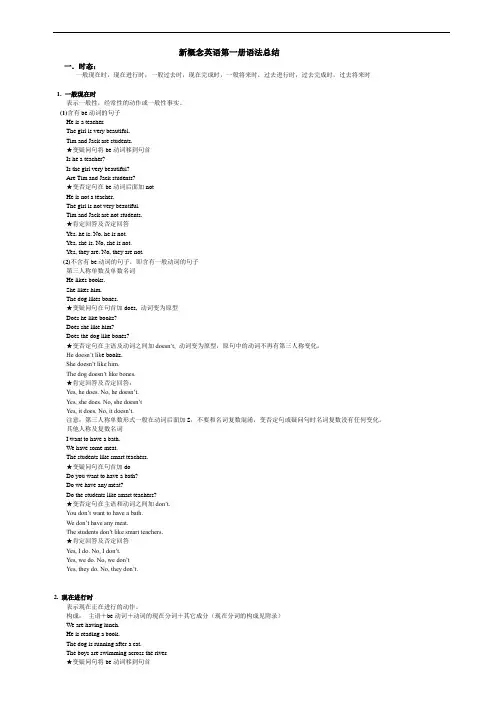
新概念英语第一册语法总结一.时态:一般现在时,现在进行时,一般过去时,现在完成时,一般将来时,过去进行时,过去完成时,过去将来时1. 一般现在时表示一般性,经常性的动作或一般性事实。
(1)含有be动词的句子He is a teacher.The girl is very beautiful.Tim and Jack are students.★变疑问句将be动词移到句首Is he a teacher?Is the girl very beautiful?Are Tim and Jack students?★变否定句在be动词后面加notHe is not a teacher.The girl is not very beautiful.Tim and Jack are not students.★肯定回答及否定回答Yes, he is. No, he is not.Yes, she is. No, she is not.Yes, they are. No, they are not.(2)不含有be动词的句子,即含有一般动词的句子第三人称单数及单数名词He likes books.She likes him.The dog likes bones.★变疑问句在句首加does, 动词变为原型Does he like books?Does she like him?Does the dog like bones?★变否定句在主语及动词之间加doesn’t, 动词变为原型,原句中的动词不再有第三人称变化。
He doesn’t lik e books.She doesn’t like him.The dog doesn’t like bones.★肯定回答及否定回答:Yes, he does. No, he doesn’t.Yes, she does. No, she doesn’tYes, it does. No, it doesn’t.注意:第三人称单数形式一般在动词后面加S,不要和名词复数混淆,变否定句或疑问句时名词复数没有任何变化。
新概念英语第一册所有语法点汇总)1.一般现在时一般现在时用来表示经常性的行为、习惯、常理或客观事实。
2.一般过去时一般过去时用来表示过去一些具体时间发生的事情。
3.一般将来时一般将来时用来表示将来一些时间或状况下会发生的事情。
4.现在进行时现在进行时用来表示现在正在进行的动作或状态。
5.过去进行时过去进行时用来表示过去一些时间正在进行的动作。
6.将来进行时将来进行时用来表示将来一些时间正在进行的动作。
7. there be句型there be句型用来表示地有人或物,用来描述存在的事物。
8.一般现在时的被动语态一般现在时的被动语态用来表示事物被做或被发生。
9.一般过去时的被动语态一般过去时的被动语态用来表示过去事物被做或被发生。
10.一般将来时的被动语态一般将来时的被动语态用来表示将来事物将被做或被发生。
11.现在进行时的被动语态现在进行时的被动语态用来表示事物正在被做或被发生。
12.过去进行时的被动语态过去进行时的被动语态用来表示过去事物正在被做或被发生。
13. do与does的用法do和does用来构成否定句、疑问句和回答。
14.现在完成时现在完成时用来表示过去发生的动作对现在造成的影响或结果。
15.现在完成进行时现在完成进行时用来表示从过去开始一直延续到现在的动作,且这个动作可能还会继续下去。
16.过去完成时过去完成时用来表示过去在一些时间或事件之前已经完成的动作。
17.过去完成进行时过去完成进行时用来表示过去一些时间持续进行的动作,这个动作在另一个过去时间之前已经结束。
18.表示数量的词表示数量的词包括数词、基数词、序数词、分数和百分数等。
19.表示频率的词表示频率的词用来描述件事情发生的频率,如常常、经常、有时、很少、从不等。
20.表示时间的词表示时间的词用来描述一些事件发生的时间,如年、月、日、星期、时、分、秒等。
21.表示地点的词表示地点的词用来描述一些事件发生的地点,如国家、城市、街道、大楼等。
新概念英语第一册语法总结➢时态:一般现在时、现在进展时、一般过去时、现在完成时、一般将来时、过去进展时、过去完成时、过去将来时★含有be动词的句子He is a teacher.The girl is very beautiful.Tim and Jack are students.★变疑问句将be动词移到句首Is he a teacherIs the girl very beautifulAre Tim and Jack students★变否认句在be动词后面加notHe is not a teacher.The girl is not very beautiful.Tim and Jack are not students.★肯定答复及否认答复Yes, he is. No, he is not.Yes, she is. No, she is not.Yes, they are. No, they are not.★含有一般动词的句子★第三人称单数及单数名词He likes books.She likes him.The dog likes bones.★变疑问句在句首加does, 动词变为原型Does he like booksDoes she like himDoes the dog like bones★变否认句在主语及动词之间加doesn’t, 动词变为原型He doesn’t like books.She doesn’t like him.The dog doesn’t like bones.★肯定答复及否认答复:Yes, he does. No, he doesn’t.Yes, she does. No, she doesn’tYes, it does. No, it doesn’t.注意:第三人称单数形式一般在动词后面加S。
★其他人称及复数名词I want to have a bath.We have some meat.The students like smart teachers.★变疑问句在句首加doDo you want to have a bathDo we have any meatDo the students like smart teachers★变否认句在主语与动词之间加don’t.You don’t want to have a bath.We don’t have any meat.The students don’t like smart teachers.★肯定答复及否认答复Yes, I do. No, I don’t.Yes, we do. No, we don’tYes, they do. No, they don’t.构成:主语+be动词+动词的现在分词+其它成分We are having lunch.He is reading a book.The dog is running after a cat.The boys are swimming across the river.★变疑问句将be动词移到句首Are we having lunchIs he reading a bookIs the dog running after a catAre the boys swimming across the river★变否认句在be动词后面加notWe are not having lunch.He is not reading a book.The dog is not running after a cat.The boys are swimming across the river.★特殊疑问句:what, which, how, where, who, etc.疑问词+be动词+主语+现在分词What are you doingWhat is she doingWhat is the dog doing没有进展时的动词(必背)表示状态、思想、感情、感觉的动词不能表示正在进展的动作1. 表示感觉、感官的词see, hear, like, love, want2. have, has作为动词〞拥有〞的含义时,没有进展时yesterday, last night, the day before yesterday, three days ago.含有be动词的句子,将动词变为过去式,am / is的变为was,are 的变为wereI was at the butcher’s.You were a student a year ago.The teacher was very beautiful ten years ago.★变疑问句将be动词移动到句首Were you at the butcher’sWere you a student a year agoWas the teacher very beautiful ten years ago★变否认句在be动词后面加notI w as not at the butcher’s.You were not a student a year ago.The teacher was not very beautiful ten years ago.★肯定答复否认答复Yes, I was. No, I was not.Yes, you were. No, you were not.Yes, he/she was. No, he/she was not.★特殊疑问句:What did you do不含有be动词的句子,将动词变为过去式,动词过去式构成见附录I finished my homework yesterday.The boy went to a restaurant.The Sawyers lived at King Streeta year ago.King Streeta year ago.★变疑问句在句首加did,动词变为原型Did you finish your homework yesterdayDid the boy go to a restaurantDid the Sawyers live at King Streeta year agoKing Streeta year ago★变否认句在主语与动词之间加did not,动词变为原型I did not finish my homework yesterday.The boy did not go to a restaurant.The Sawyers did not live at King Streeta year ago.King Streeta year ago.★肯定答复及否认答复Yes, I did. No, I didn’t.Yes, he did. No, he didn’t.Yes, they did. No, they did not.have/has+过去分词用法:1)表示过去发生且与现在有某种联系的动作,常与just, usually, already, since等时间副词连用I have just had lunch. (饱了,不用再吃了)He has had a cup of tea.〔不渴了,不用再喝〕They have already had their holiday. 〔不能再度假了〕The boy has already read the book. 〔已经知道书的内容了,不用再看了〕2)询问别人是否做过某事一般用现在完成时Have you finished your homeworkHave you been to BeijingHave he seen the film3)表示开场于过去并持续到现在的动作I have lived in Beijing for twenty years.I have worked for this school for 1 year.4)表示一种经历、经历:去过…地方,做过…事情,经历过…事情I have never had a bath.I have never seen a film.I have never been to cinema.I have ever been to Paris.Have been to表示去过,have gone to 表示去了I have been to London.(人已经回来)He has gone to London.〔人还在那里〕5)表示一种结果,一般不与时间副词联用I have lost my pen.I have hurt myself.He has become a teacher.She has broken my heart.句型变化:★变疑问句将助动词移到句首,变否认句在助动词后面加not. Have you lost your pen I have not lost my pen.★肯定答复及否认答复Yes, I have. No, I have not.★特殊疑问句:What have you doneWhat has he done一般过去时与现在完成时的区别:但凡有明确的表示过去的时间状语的句子为过去时注意:有些动词表示的动作有一个终点,不能再延续,因此不能与表示一段时间状语连用错:I’ve left Beijing for 3 days.对:I left Beijing 3 days ago. I have been away from being for 3 days.经常与tomorrow, next year, the day after tomorrow, the year after the next, in five hours’ time, etc. 表示将来的词联用构造:主语+助动词will+动词原形I will go to America tomorrow.The pilot will fly to Japan the month after the next.Jack will move into his new house tomorrow morning.★变疑问句将助动词移到句首Will you go to America tomorrowWill the pilot fly to Japan the month after the nextWill Jack move into his new house tomorrow morning★变否认句在助动词后面加notI will not go to America tomorrow.The pilot will not fly to Japan the month after the next. Jack will not move into his new house tomorrow morning★肯定答复及否认答复Yes, I will. No, I will not.Yes, he/she will. No, he/she will not.Yes, he will. No, he will not.★特殊疑问句:What will you do完成时。
新概念英语第一册语法总结〔上〕[八种时态] 一.时态:一般现在时,现在进行时,一般过去时,现在完成时,一般将来时,过去进行时,过去完成时,过去将来时1.一般现在时表示一般性,经常性的动作或一般性事实。
含有be动词的句子He is a teacher.The girl is very beautiful.Tim and Jack are students.★变疑问句将be动词移到句首Is he a teacher?Is the girl very beautiful?Are Tim and Jack students?★变否认句在be动词后面加notHe is not a teacher.The girl is not very beautiful.Tim and Jack are not students.★肯定答复及否认答复Yes, he is. No, he is not.Yes, she is. No, she is not.Yes, they are. No, they are not.不含有动词的句子,即含有一般动词的句子第三人称单数及单数名词He likes books.She likes him.The dog likes bones.★变疑问句在句首加does, 动词变为原型Does he like books?Does she like him?Does the dog like bones?★变否认句在主语及动词之间加doesn’t, 动词变为原型He doesn’t like books.She doesn’t like him.The dog doesn’t like bones.★肯定答复及否认答复:Yes, he does. No, he doesn’t.Yes, she does. No, she doesn’tYes, it does. No, it doesn’t.注意:第三人称单数形式一般在动词后面加S,不要和名词复数混淆,变否认句或疑问句时名词复数没有任何变化。
新概念英语第一册语法知识点Company number:【WTUT-WT88Y-W8BBGB-BWYTT-19998】★含有be动词的句子He is a teacher.The girl is very beautiful.Tim and Jack are students.★变疑问句将be动词移到句首Is he a teacherIs the girl very beautifulAre Tim and Jack students★变否定句在be动词后面加notHe is not a teacher.The girl is not very beautiful.Tim and Jack are not students.★肯定回答及否定回答Yes, he is. No, he is not.Yes, she is. No, she is not.Yes, they are. No, they are not.★含有一般动词的句子★第三人称单数及单数名词He likes books.She likes him.The dog likes bones.★变疑问句在句首加does, 动词变为原型Does he like booksDoes she like himDoes the dog like bones★变否定句在主语及动词之间加doesn’t, 动词变为原型He doesn’t like books.She doesn’t like him.The dog doesn’t like bones.★肯定回答及否定回答:Yes, he does. No, he doesn’t.Yes, she does. No, she doesn’tYes, it does. No, it doesn’t.注意:第三人称单数形式一般在动词后面加S。
★其他人称及复数名词I want to have a bath.We have some meat.The students like smart teachers.★变疑问句在句首加doDo you want to have a bathDo we have any meatDo the students like smart teachers★变否定句在主语和动词之间加don’t.You don’t want to have a bath.We don’t have any meat.The students don’t like smart teachers.★肯定回答及否定回答Yes, I do. No, I don’t.Yes, we do. No, we don’tYes, they do. No, they don’t.构成:主语+be动词+动词的现在分词+其它成分We are having lunch.He is reading a book.The dog is running after a cat.The boys are swimming across the river.★变疑问句将be动词移到句首Are we having lunchIs he reading a bookIs the dog running after a catAre the boys swimming across the river★变否定句在be动词后面加notWe are not having lunch.He is not reading a book.The dog is not running after a cat.The boys are swimming across the river.★特殊疑问句:what, which, how, where, who, etc.疑问词+be动词+主语+现在分词What are you doingWhat is she doingWhat is the dog doing没有进行时的动词(必背)表示状态、思想、感情、感觉的动词不能表示正在进行的动作1. 表示感觉、感官的词see, hear, like, love, want2. have, has作为动词”拥有”的含义时,没有进行时yesterday, last night, the day before yesterday, three days ago.含有be动词的句子,将动词变为过去式,am / is的变为was,are的变为wereI was at the butcher’s.You were a student a year ago.The teacher was very beautiful ten years ago.★变疑问句将be动词移动到句首Were you at the butcher’sWere you a student a year agoWas the teacher very beautiful ten years ago★变否定句在be动词后面加notI was not at the butcher’s.You were not a student a year ago.The teacher was not very beautiful ten years ago.★肯定回答否定回答Yes, I was. No, I was not.Yes, you were. No, you were not.Yes, he/she was. No, he/she was not.★特殊疑问句:What did you do不含有be动词的句子,将动词变为过去式,动词过去式构成见附录I finished my homework yesterday.The boy went to a restaurant.The Sawyers lived at King Streeta year ago.King Streeta year ago.★变疑问句在句首加did,动词变为原型Did you finish your homework yesterdayDid the boy go to a restaurantDid the Sawyers live at King Streeta year agoKing Streeta year ago★变否定句在主语和动词之间加did not,动词变为原型I did not finish my homework yesterday.The boy did not go to a restaurant.The Sawyers did not live at King Streeta year ago.King Streeta year ago.★肯定回答及否定回答Yes, I did. No, I didn’t.Yes, he did. No, he didn’t.Yes, they did. No, they did not.have/has+过去分词用法:1)表示过去发生且和现在有某种联系的动作,常和just, usually, already,since等时间副词连用I have just had lunch. (饱了,不用再吃了)He has had a cup of tea.(不渴了,不用再喝)They have already had their holiday. (不能再度假了)The boy has already read the book. (已经知道书的内容了,不用再看了)2)询问别人是否做过某事一般用现在完成时Have you finished your homeworkHave you been to BeijingHave he seen the film3)表示开始于过去并持续到现在的动作I have lived in Beijing for twenty years.I have worked for this school for 1 year.4)表示一种经历、经验:去过…地方,做过…事情,经历过…事情I have never had a bath.I have never seen a film.I have never been to cinema.I have ever been to Paris.Have been to表示去过,have gone to 表示去了I have been to London.(人已经回来)He has gone to London.(人还在那里)5)表示一种结果,一般不和时间副词联用I have lost my pen.I have hurt myself.He has become a teacher.She has broken my heart.句型变化:★变疑问句将助动词移到句首,变否定句在助动词后面加not.Have you lost your pen I have not lost my pen.★肯定回答及否定回答Yes, I have. No, I have not.★特殊疑问句:What have you doneWhat has he done一般过去时与现在完成时的区别:凡是有明确的表示过去的时间状语的句子为过去时注意:有些动词表示的动作有一个终点,不能再延续,因此不能和表示一段时间状语连用错:I’ve l eft Beijing for 3 days.对:I left Beijing 3 days ago. I have been away from being for 3 days.经常和tomorrow, next year, the day after tomorrow, the year after the next, in five hours’ time, etc. 表示将来的词联用结构:主语+助动词will+动词原形I will go to America tomorrow.The pilot will fly to Japan the month after the next.Jack will move into his new house tomorrow morning.★变疑问句将助动词移到句首Will you go to America tomorrowWill the pilot fly to Japan the month after the nextWill Jack move into his new house tomorrow morning★变否定句在助动词后面加notI will not go to America tomorrow.The pilot will not fly to Japan the month after the next.Jack will not move into his new house tomorrow morning★肯定回答及否定回答Yes, I will. No, I will not.Yes, he/she will. No, he/she will not.Yes, he will. No, he will not.★特殊疑问句:What will you do结构:had+过去分词After she had finished her homework, she went shopping.They had sold the car before I asked the price.The train had left before I arrived at the station.After/before引导的时间状语从句放在句首要在句子后面加逗号,如果放在主句后则不用。
现在进行时:现在进行时表示说话时正在进行或发生的动作,也可表示当前一段时间内的活动。
1. 结构:主语+ be (is/am/are) + 动词ing + 其他PS: be动词要根据前面的主语变化(she/he/it is) (I am)(you/we/they are)例:我正在打篮球I am playing basketball.2. 否定句:主语+ be (is/am/are) + not + 动词ing + 其他例:我没有在打篮球I am not playing basketball.3. 一般疑问句:be (is/am/are) + 主语+ 动词ing + 其他?例:你正在打篮球吗?Are you playing basketball?4. 特殊疑问句:What(什么)Where(哪里)When(什么时候) + be (is/am/are) + 主语+ 动词ing + 其他?Who(谁)Why(为什么)How(怎么)例:你正在做什么?What are you doing?你正在哪里打篮球?Where are you playing basketball?你什么时候正在打篮球?When are you playing basketball?你正在见谁?Who are you meeting?你为什么在打篮球?Why are you playing basketball?你现在怎么能打篮球啊?How are you playing basketball?常搭配的时间短语:now, at the moment, at present一般现在时:1.经常性、习惯性动作(如:我每天都洗澡/他每天早上都上学)2.客观事实(如:我住在昆明/我爱中国)3.客观真理(如:太阳从东边升起/地球绕着太阳转)1.结构:1)主语(I/you/we/they)+ 动词原形+ 其他例:我住在昆明I live in Kunming.他们每天早上都去上学They go to school every morning.2)主语(单数第三人称he/she/it)+ 动词s+ 其他PS:以o结尾的动词,加es以辅音字母+y结尾的动词,改y为i加es例:他住在昆明He lives in Kunming.她每天早上都去上学She goes to school every morning.2.否定句:1)主语(I/you/we/they)+ don 't + 动词原形+ 其他例:我不住在昆明I don 't live in Kunming.他们每天早上都不去上学:They don 't go to school every morning.2)主语(单数第三人称he/she/it)+ doesn't + 动词原形+ 其他例:他不住在昆明He doesn't live in Kunming.她每天早上都不去上学She doesn't go to school every morning.3.一般疑问句:1)Do + 主语(I/you/we/they)+ 动词原形+ 其他?回答:Yes, 主语(I/you/we/they)+ do.No, 主语(I/you/we/they)+ don 't.例:你住在昆明吗?Do you live in Kunming?Yes, I do. / No, I don 't.他们每天都去上学吗?Do they go to school every day?Yes, they do. / No, they don 't.2)does + 主语(单数第三人称he/she/it)+ 动词原形+ 其他?回答:Yes, 主语(单数第三人称he/she/it)+ does.No, 主语(单数第三人称he/she/it)+ doesn't.例:他住在昆明吗?Does he live in Kunming?Yes, he does. / No, he doesn't.她每天都去上学吗?Does she go to school every day?Yes, she does. / No, she doesn't4.特殊疑问句:1)What(什么)Where(哪里)When(什么时候) + do + 主语(I/you/we/they)+ 动词原形+ 其他?Who(谁)Why(为什么)How(怎么)例:你每天早上做什么?What do you do every morning?你每天早上去哪里?Where do you go every morning?你每天什么时候去上学?When do you go to school every day?你每天都见谁?Who do you meet every day?你为什么喜欢中国?Why do you like China?你每天都怎么去上学?How do you go to school every day?2)What(什么)Where(哪里)When(什么时候) + does + 主语(单数第三人称he/she/it)+ 动词原形+ 其他?Who(谁)Why(为什么)How(怎么)例:他每天早上做什么?What does he do every morning?他每天早上去哪里?Where does he go every morning?他每天什么时候去上学?When does he go to school every day?他每天都见谁?Who does he meet every day?他为什么喜欢中国?Why does he like China?他每天都怎么去上学?How does he go to school every day?常搭配的时间:sometimes有时,often经常,usually通常,always总是,在早上:in the morning 每天早上:every morning在下午:in the afternoon 每天下午:every afternoon在傍晚:in the evening 每天傍晚:every evening在晚上:at night 每天晚上:every night每天/周/月/年:every day/week/month/year一般过去时:表示过去某个时间发生而现在已经结束的动作或存在的状态。
新概念英语第一册语法规则新概念英语第一册语法规则:时态1、一般现在时:(除主语第三人称)谓语动词都使用动词原形。
常与副词“always”,“never”,“often”,“seldom”,“usually”,“every”,“day”等连用。
2、现在实行时:表示现在正在实行的动作。
语法:Be+动词现在分词3、现在完成时:表动作发生在过去,但与现在相关系。
即用一个发生在过去的动作来说明现在的情况。
语法:Have+动词过去分词4、一般过去时:表过去某个时间发生的动作或存有的状态,也表示过去常发生的动作。
语法1(be动词):主语+be动词过去式语法2:主语+动词过去式5、过去实行时:表某一时刻或某一段时间内正在实行或持续实行的作动。
语法:Be动词过去式+动词现在分词6、过去完成时:表在过去某一时间或动作以前己经完成的动作。
语法:Had+动词过去分词构成7、一般将来时:表将来某个时间要发生的动作或存有的状态,也表将来经常或反复发生的动作。
语法1:Will(Shall)+动词原形语法2:Be+going go+动词原形8、过去将来时:表从过去某一时间看将要发生的动作或存有的状态。
语法1:Would(Should)+动词原形语法2:Be动词过去式+going to+动词原形新概念英语第一册语法规则:从句一、宾语从句:宾语从句是由一个完整的句子构成,充当宾语修饰谓语动词、介词和、限定动词和某些形容词的宾语。
如果从句部份是一个陈述句或是一个一般疑句(一般疑问句如果做为从句则需变为陈述句)则通常使用引导词“that”、“whether”、“if”加上从句部份来构成宾语从句。
如果从句部份是一个特殊疑问句,而把特殊疑问词做引导词在加上由一般疑问句变来的陈述句来构成宾语从句。
例1:由that、whether或if引导的宾语从句。
1、She saw that her was sleeping. 她看见他在睡觉(修饰谓语动词“saw”)。
新概念英语第一册语法总结(上)[ 八种时态] 一.时态:一般现在时,现在进行时,一般过去时,现在完成时,一般将来时,过去进行时,过去完成时,过去将来时1. 一般现在时表示一般性,经常性的动作或一般性事实。
含有be 动词的句子He is a teacher.The girl is very beautiful.Tim and Jack are students.★变疑问句将be 动词移到句首Is he a teacher?Is the girl very beautiful?Are Tim and Jack students?★变否定句在be 动词后面加notHe is not a teacher.The girl is not very beautiful.Tim and Jack are not students.★肯定回答及否定回答Yes, he is. No, he is not.Yes, she is. No, she is not.Yes, they are. No, they are not.不含有动词的句子,即含有一般动词的句子第三人称单数及单数名词He likes books.She likes him.The dog likes bones.★变疑问句在句首加does, 动词变为原型Does he like books?Does she like him?Does the dog like bones?★变否定句在主语及动词之间加doesn’t动, 词变为原型He doesn ’t like books.She doesn ’t like him.The dog doesn ’t like bones.★肯定回答及否定回答:Yes, h e does. No, he doesn ’ t.Yes, she does. No, she doesn ’tYes, it does. No, it doesn ’t.注意:第三人称单数形式一般在动词后面加S,不要和名词复数混淆,变否定句或疑问句时名词复数没有任何变化。
其他人称及复数名词I want to have a bath.We have some meat.The students like smart teachers.★变疑问句在句首加doDo you want to have a bath?Do we have any meat?Do the students like smart teachers?★变否定句在主语和动词之间加don’t.You don ’t want to have a bath.We don’t have any meat.The students don ’t like smart teachers.★肯定回答及否定回答Yes, I do. No, I don ’ t.Yes, we do. No, we don ’tYes, they do. No, t hey don ’t.2. 现在进行时表示现在正在进行的动作。
构成:主语+be 动词+动词的现在分词+其它成分(现在分词的构成见附录)We are having lunch.He is reading a book.The dog is running after a cat.The boys are swimming across the river.★变疑问句将be 动词移到句首Are we having lunch?Is he reading a book?Is the dog running after a cat?Are the boys swimming across the river?★变否定句在be 动词后面加notWe are not having lunch.He is not reading a book.The dog is not running after a cat.The boys are swimming across the river.★特殊疑问句:what, which, how, where, who, etc.疑问词+动词+主语+现在分词What are you doing?What is she doing?What is the dog doing?(必背)没有进行时的动词表示状态,思想,感情和感觉的动词不能表示正在进行的动作1. 表示感觉,感官的词see, hear, like, love, want,2. have, has当”拥有”讲时没有进行时3. 一般过去时表示过去发生的动作或事件,常和表示过去的时间状语连用,如yesterday, last night, the day before yesterday, 3 days ago,含有be 动词的句子,将动词变为过去式,am, is 的过去式为was,are 的过去式为wereI was at the butcher ’s.You were a student a year ago.The teacher was very beautiful ten years ago.★变疑问句将be 动词移动到句首Were you at the butcher ’s?Were you a student a year ago?Was the teacher very beautiful ten years ago?★变否定句在be 动词后面加notI was not at the butcher ’s.You were not a student a year ago.The teacher was not very beautiful ten years ago.★肯定回答否定回答Yes, I was. No, I was not.Yes, you were. No, you were not. Yes,he/she was. No, he/she was not.★特殊疑问句:What did you do?(必背)不含有be 动词的句子,将动词变为过去式,动词过去式构成见附录I finished my homework yesterday.The boy went to a restaurant.The Sawyers lived at King Street a year ago.King Street a year ago.★变疑问句在句首加did,动词变为原型Did you finish your homework yesterday?Did the boy go to a restaurant?Did the Sawyers live at King Street a year ago?King Street a year ago?★变否定句在主语和动词之间加did notI did not finish my homework yesterday.The boy did not go to a restaurant.The Sawyers did not live at King Street a year ago.King Street a year ago.★肯定回答及否定回答Yes, I did. No, I didn ’ t.Yes, he did. No, he didn ’t.Yes, they did. No, they did not.4. 现在完成时构成:主语+助动词have, has+过去分词用法:1) 表示过去发生的和现在有某种联系的动作,常和just, usually, already, since 等时间副词连用I have just had lunch. (饱了,不用再吃了)He has had a cup of tea(. 不渴了,不用再喝)They have already had their holiday. (不能再度假了)The boy has already read the book.(已经知道书的内容了,不用再看了)2)询问别人是否做过某事一般用现在完成时:Have you finished your homework?Have you been to Beijing?Have he seen the film?3) 表示开始于过去并持续到现在的动作I have lived in Beijing for twenty years.I have worked for this school for 1 year.4) 表示一种经历,经验:去过地方,做过事情,经历过事情I have never had a bath.I have never seen a film.I have never been to cinema.I have ever been to Paris.Have been to表示去过,have gone to 表示去了I have been to London.(人已经回来)He has gone to London(. 人还在那里)5) 表示一种结果,一般不和时间副词联用I have lost my pen.I have hurt myself.He has become a teacher.She has broken my heart.句型变化:★变疑问句将助动词移到句首,变否定句在助动词后面加not.e.g. Have you lost your pen? I have not lost my pen.★肯定回答及否定回答Yes, I have. No, I have not.★特殊疑问句:What have youdone? What has hedone?一般过去时与现在完成时的区别:凡是有明确的表示过去的时间状语的句子为过去时注意:有些动词表示的动作有一个终点,不能再延续,因此不能和表示一段时间状语连用错:I ’ve left Beijing for 3 days.对:I left Beijing 3 days ago. I have been away from being for 3 days.5. 一般将来时表示将来将要发生的动作,经常和tomorrow, next year, the day after tomorrow, the year after the next, in five hours ’t表im示e,将et来c.的词联用结构:主语+助动词will+ 动词原形I will go to America tomorrow.The pilot will fly to Japan the month after the next.Jack will move into his new house tomorrow morning.★变疑问句将助动词移到句首Will you go to America tomorrow?Will the pilot fly to Japan the month after the next?Will Jack move into his new house tomorrow morning?★变否定句在助动词后面加notI will not go to America tomorrow.The pilot will not fly to Japan the month after the next.Jack will not move into his new house tomorrow morning★肯定回答及否定回答Yes, I will. No, I will not.Yes, he/she will. No, he/she will not.Yes, he will. No, he will not.★特殊疑问句:What will you do?6. 过去完成时:用法:在过去的时间里,两个动作中,发生在前的哪个动作要用过去完成时。